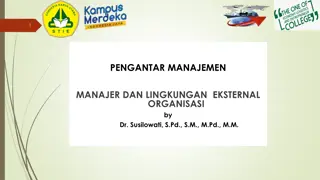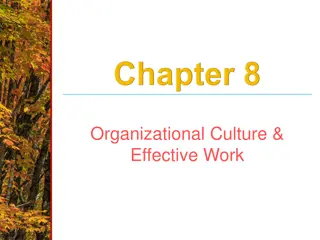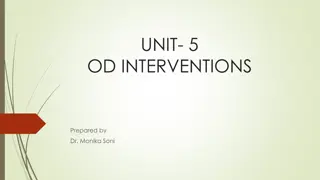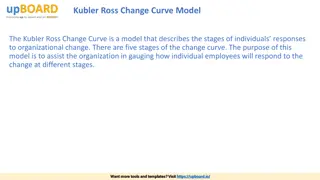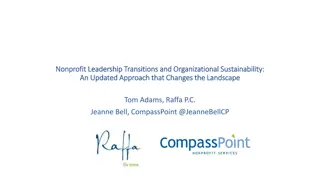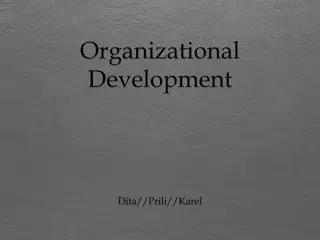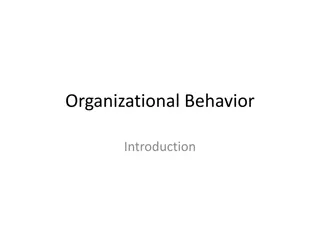Navigating Organizational Change for Better Outcomes
Embrace culture change by prioritizing a Restraint/Seclusion Action Plan using evidence-based strategies. Overcoming challenges like inertia and resistance, leadership plays a critical role in success. Learn from John Kotter's Eight Steps for Leading Change and work collaboratively to address barriers and foster innovation.
Download Presentation

Please find below an Image/Link to download the presentation.
The content on the website is provided AS IS for your information and personal use only. It may not be sold, licensed, or shared on other websites without obtaining consent from the author.If you encounter any issues during the download, it is possible that the publisher has removed the file from their server.
You are allowed to download the files provided on this website for personal or commercial use, subject to the condition that they are used lawfully. All files are the property of their respective owners.
The content on the website is provided AS IS for your information and personal use only. It may not be sold, licensed, or shared on other websites without obtaining consent from the author.
E N D
Presentation Transcript
Agree to take this issue on as a priority Create a Team/Work Group to develop a Restraint/Seclusion Action Plan Formulate a plan to coincide with the six core evidence-based strategies
Leadership Towards Organizational Change Use of Data to Inform Practice Workforce Development Use of Restraint and Seclusion Prevention Tools Full Inclusion of Consumers and Families Rigorous Debriefing
Its difficult to overcome inertia You may have too much on your plate Training staff on new practices requires time and expertise Clinicians and staff may disagree with new approaches 4
Leadership is critical in the success of your Project!! You are the leaders Create a positive vision Better outcomes for consumers Latest and best evidence Let s do it! message Communicate importance and commitment Engage hospital leadership and Board 5
John Kotter of Harvard Business School studied why transformation efforts fail and suggested Eight Steps for Leading Change 1. 2. 3. 4. 5. 6. 7. 8. Establishing a Sense of Urgency Forming a Powerful Guiding Coalition Creating a Vision Communicating the Vision Empowering Others to Act on the Vision Planning for and Creating Short-term wins Consolidating Improvements and Producing Still More Change Institutionalizing New Approaches Focus: Communicating the Vision Simplicity Multiple forms Repetition Leadership by example Explanation of seeming inconsistencies Give and take 6 John P. Kotter, Leading Change: Why Transformation Efforts Fail, Harvard Business School Press, 1995
Work as a Team rather than as individuals Establish standing (regular) meetings and reporting mechanisms Standing agenda item for meetings of Team and Executive Leadership Develop a plan Identify barriers to implementation and address or mitigate problems Encourage thinking outside the box Have a kick-off date 7
Implementation of plan Not too fast don t have kick off until ready to implement initial series of steps Not too slow avoid long lags between implementation of steps Start with Small Successes Monitor process and outcome data Is the plan being carried out? Is the plan having intended effects? Review and respond to data 8
Assure review of data by leadership and team Make processes and outcomes transparent Educate and engage staff (clinical, medical and support staff) about the project Share WHAT WORKED and WHAT DID NOT Compare results across wards in a hospital Call your colleagues/network
With both staff and individuals in care As Management does unto Staff So shall Staff do unto Consumers Strength-based supervision for staff Use three buckets or red rules/green rules with individuals in care Offer choices Respectful interactions
Promote calm, nurturing, healing environments signage Model caring, compassionate behavior Demonstrate active listening Interview and observe for triggers Adjust environment to prevent triggers Use full range of prevention tools Model, teach, model, teach - i.e., shape the behavior you want to see
Persistence and sustained attention Don t get discouraged
Jayne Van Bramer Director, Office of Quality Management New York State Office of Mental Health 44 Holland Avenue Albany, New York 12229 (518) 474-4447 Jayne.VanBramer@omh.ny.gov


